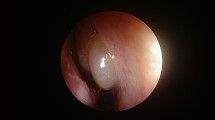Abstract
To assess if sensation of nasal mucosa affect the subjective sensation of nasal patency. This is a case control study with 50 patients, using 2% lignocaine as the active drug and normal saline as the placebo (2 groups of 25 patients each). Each subject had 2 ml of solution sprayed into the test nose. These subjects had no prior nasal symptoms, allergy or surgery. They were evaluated subjectively using Likert scale and objectively by acoustic rhinometry before and after lignocaine or normal saline. The patients in both normal saline and lignocaine groups demonstrated no significant change based upon Likert scale. The study also demonstrated the mean cross sectional area 1 (CSA1), mean cross sectional area 2 (CSA2), with mean Volume 1 and mean Volume 2, these results did not vary significantly in both groups with Acoustic Rhinometry. The analysis thus shows that the use of topical anesthetic spray on nasal mucosa produces no objective effect on nasal resistance or subjective sensation of altered nasal patency. Thus the study concludes that, tactile sensation of nasal mucosa does not play a role in the sensation of nasal obstruction.

Similar content being viewed by others
References
Jones AS, Lancer JM, Shone G, Steven JC (1986) The effect of lignocaine on nasal resistance and sensation of airflow. Acta Otolaryngol 101:328–330
Jones AS, Lancer JM, Moir AA, Stevens JC (1985) The effect of sub-mucosal diarthermy to the inferior turbinates on nasal resistance to airflow in allergic and vasomotor rhinitis. Clin Otolaryngol 10:249–252
Grymer LF, Hilberg O, Pederson OF (1996) Prediction of nasal obstruction based on clinical examination and acoustic rhinometry. Rhinology 35:53–57
Elbrone O, Felding JU, Gustavsen KM (1991) Acoustic rhinometry used as a method to monitor the effect of intramuscular injection of steroid in the treatment of nasal polyps. J Laryngol Otol 105:178–180
Tomkinson A, Eccles R (1996) Acoustic rhinometry; Do we need a standardized operating procedure? Clin Otolaryngol 21:284–287
Jones AS, Wright RG, Crosher R, Durham LH (1989) Nasal sensation of airflow following blockade of the nasal trigeminal afferents. Clin Otolaryngol 14:285–289
Burrow A, Eccles R, Jones AS (1983) The effect of camphor, eucalyptus and menthol vapour on nasal resistance to airflow and nasal sensation. Acta Otolaryngol (Stockh) 96:157–161
Eccles R, Jones AS (1983) The effect of menthol on nasal resistance to airflow. J Laryngol Otol 97:705–709
Eccles R, Morris S, Tolley NS (1988) The effect of nasal anesthesia upon nasal sensation of airflow. Acta Otolaryngol (Stockh) 106:152–155
Proctor DF, Adam KA III (1976) Physiology and pharmacology of nasal function and mucous secretion. Pharmac Ther B 2:393–409
Corey JP, Patel A, Amy BS, Mamikoglu B (2002) Clinical applications of acoustic rhinometry. Curr Opin Otolaryngol Head And Neck Surg 10:22–25
Hilberg O, Pederson OF (2000) Acoustic rhinometry: recommendations for technical specification and standard operating procedures. Rhinol Suppl 16:3–17
Grymer LF, Hilberg O, Elbrond O, Pedersen OF (1989) Acoustic rhinometry: evaluation of the nasal cavity with septal deviation, before and after septoplasty. Laryngoscope 99:1180–1187
Grymer LF (2000) Clinical applications of acoustic rhinometry. Rhinol Suppl 16:35–43
Lai VNS, Corey JP (1994) The use of acoustic rhinometry to quantitatively assess changes after intranasal allergen challenge. Am J Rhinol 8:171–173
Author information
Authors and Affiliations
Corresponding author
Rights and permissions
About this article
Cite this article
Dipak, S., Prepageran, N., Haslinda, S. et al. The Role of Sensation in Subjective and Objective Evaluation of Nasal Patency. Indian J Otolaryngol Head Neck Surg 63, 10–14 (2011). https://doi.org/10.1007/s12070-010-0067-8
Received:
Accepted:
Published:
Issue Date:
DOI: https://doi.org/10.1007/s12070-010-0067-8




